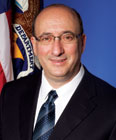 Reflecting on a summer that saw a record number of heat-related weather emergencies across the country, OSHA chief Dr. David Michaels said there’s no way of knowing how many workers are alive and well right now because their employers took steps to reduce the risk of heat-related illness.
Reflecting on a summer that saw a record number of heat-related weather emergencies across the country, OSHA chief Dr. David Michaels said there’s no way of knowing how many workers are alive and well right now because their employers took steps to reduce the risk of heat-related illness.
In the coming months, however, the Labor Department’s Bureau of Labor Statistics will release the estimated number of heat-related fatalities for 2012.
Whatever those figures turn out to be, “Not one worker’s life should be endangered by these entirely preventable illnesses,” said Michaels, writing in Work in Progress, the official blog of the U.S. Labor Dept.
OSHA's heat safety campaign
For the second year in a row, OSHA conducted a summerlong campaign to hammer that point home to both workers and employers. It started when the agency partnered with the National Weather Service to urge TV and radio weather broadcasters to discuss just how deadly extreme heat can be for outdoor workers and to urge them to spread the message about heat’s dangers to outdoor worker and their families.
In what Michaels described as a “grueling” July and August, the campaign expanded to broadcast PSAs and live, Spanish-language phone banks on Univision staffed by OSHA personnel, who answered questions from the public about heat illness prevention.
OSHA also distributed more than half a million educational posters, fact sheets, tools and other resources and raised more than 100 “Water. Rest. Shade.” billboards in Arkansas, Florida, Texas and Illinois – the four states with the highest number of occupational heat-related fatalities in 2010.
Vulnerable workers, limited English
Michaels said the agency was especially concerned about “hard-to-reach, vulnerable workers who may have limited English proficiency or may work in remote areas in industries like agriculture or construction.”
An OSHA Heat Safety Tool, a mobile smartphone application that provides vital safety information was downloaded more than 54,000 times in English and Spanish on the iPhone, and Android and some Blackberry devices.
“We can’t count the number of workers who recognized the signs of heat stroke or heat exhaustion in a co-worker and took action to get life-saving medical help,” wrote Michaels. “There is no telling what might have happened to the workers whose employers conducted comprehensive heat illness prevention training, and who – as a result – stayed hydrated and took frequent breaks in the shade during the summer’s most unforgiving days.”
He said workers did die in the U.S. this summer from the effects of heat-related illnesses.
“When word of these fatalities reaches us at OSHA’s national office during our videoconferences with our regional administrators, the room goes silent, and all of us share the sense of loss. We grieve for the loved ones of these workers and resolve to keep fighting.”
Click here to read the entire blog post.

